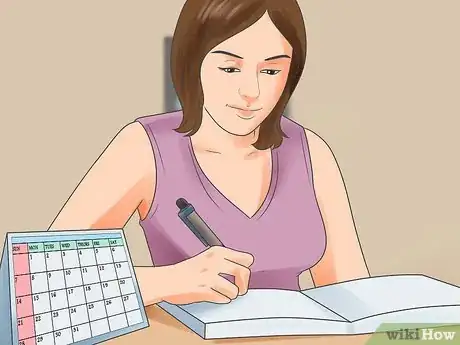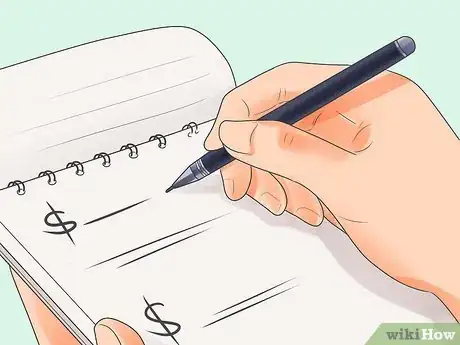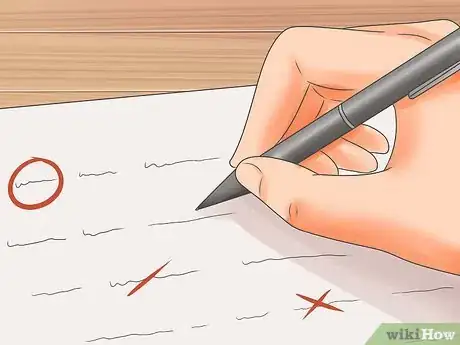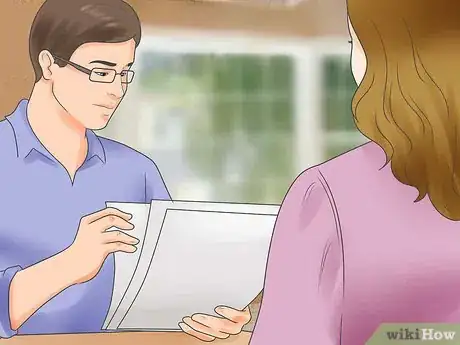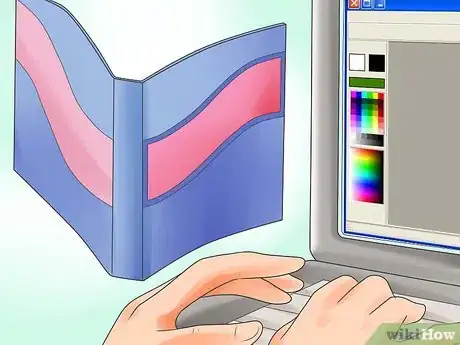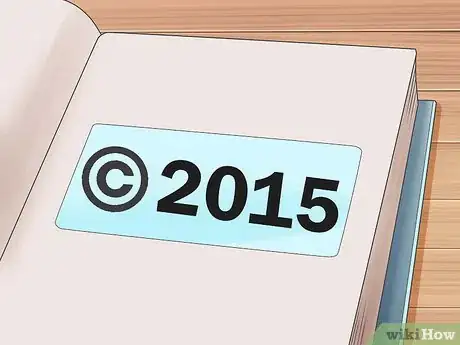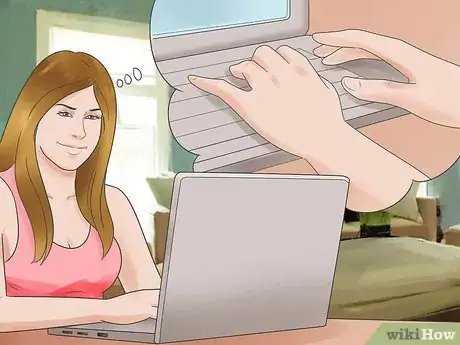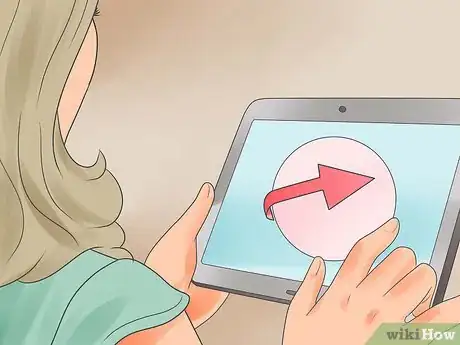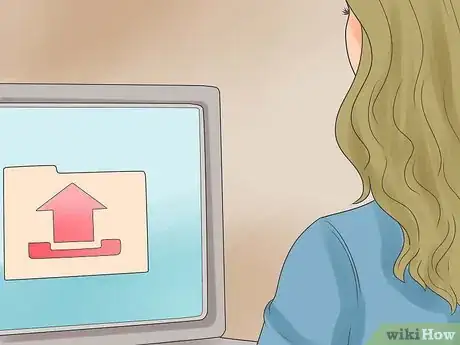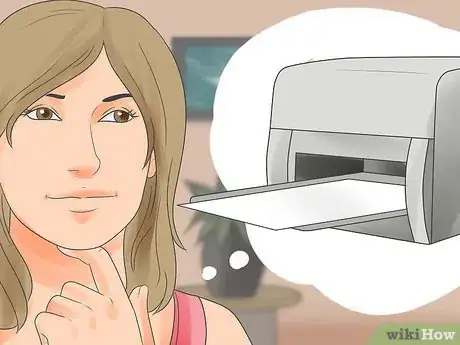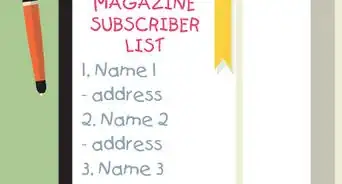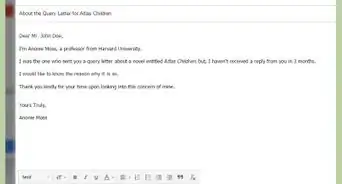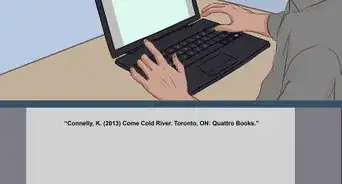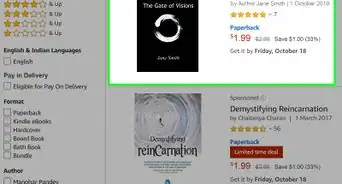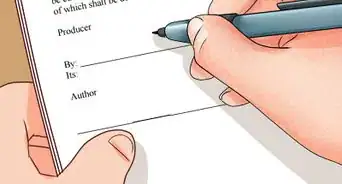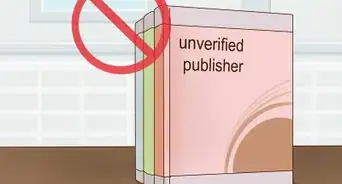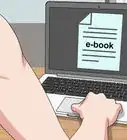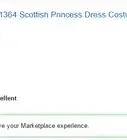This article was co-authored by Grant Faulkner, MA. Grant Faulkner is the Executive Director of National Novel Writing Month (NaNoWriMo) and the co-founder of 100 Word Story, a literary magazine. Grant has published two books on writing and has been published in The New York Times and Writer’s Digest. He co-hosts Write-minded, a weekly podcast on writing and publishing, and has a M.A. in Creative Writing from San Francisco State University.
wikiHow marks an article as reader-approved once it receives enough positive feedback. This article received 31 testimonials and 84% of readers who voted found it helpful, earning it our reader-approved status.
This article has been viewed 729,245 times.
Self publishing a book is popular for many reasons. Securing a traditional publishing contract may not work for you — they're hard to get, and you give up a lot of rights when you finally do get one. Self-publishing should allow you to retain more rights over the final product, offer the product at a substantially lower cost, and give you an outlet to do traditional marketing and advertising yourself. No matter what your reason, self publishing is a great way to make your book available to anybody interested. Read on for a discussion of the different ways that you can self-publish a book.
Steps
Writing, Proofing, Designing, and Copywriting
-
1Know that writing a book takes lots of hard work and time. You could spend anywhere from 4 to 12 hours a day writing, for a period of a several months to a year. If you're serious about writing, allocate a significant portion of the day in order to brainstorm, write, and revise.
- Many writers find that they are most productive and imaginative right when they get up in the morning. Find out what time of the day works for you and set aside time during that period to write.
- Don't forget to read while you write. Reading is the superfood that keeps writers nourished. Set aside time during your day, if you haven't already, to seriously engage with books and the ideas in them.
-
2Be prepared. Self publishing takes a lot of initiative and drive. Remember that it is your passion for making your book and getting it out to the public that will carry you through the frustrations you will most certainly encounter along the way. That being said, self-publishing can be an exciting and profitable venture. It is kind of fun to self-publish your book in the internet.Advertisement
-
3Explore your options. Decide if self publishing is the right choice for you. Talk to a few publishing companies and compare cost to benefit ratio. List the reasons why you want to self-publish your book, and get an estimate on how much it will cost; cover art, book designing, editing and formatting can all be quite expensive. Determine whether the reason you're publishing is strong enough to outweigh the cost, and providing that it does, keep going.
- A breakdown of the rough costs[1]
[2]
of self-publishing may look like this:
- Formatting: $0 (DIY) - $150 and beyond, although you shouldn't be spending lots of money here.
- Cover art design: $0 (DIY) - $1,000. Know that if you opt for an e-book creation business, they'll likely just use stock photos.
- Editing: $0 (DIY) - $3,000 for "developmental" (substantive) editing. Many first-time publishers expect to pay around $500 for a combination of proofreading and copyediting.
- A breakdown of the rough costs[1]
[2]
of self-publishing may look like this:
-
4Proof your book. Make sure that it is complete, well-edited, and thoroughly proofread. You might give a manuscript out to a few trusted friends who will give you valuable feedback, and talk with you about facts, or motivations for the characters, or other minutiae about your book.
- If you're part of a writing community or a frequent participant on a forum, consider using that forum as a source of free (or relatively free) advice. Forums feature dedicated fans who are inspired to help other people along the way, and for whom proofing might be a huge source of pride.
- Proofing often takes several go-arounds until all the errors, formatting mistakes, and stylistic boo-boos are wrinkled out. Especially if you are relying on someone's free services, it could take two or three read-throughs to get the book proofed. Even then, don't expect it to be flawless.
-
5Hire an editor. Hire a good one that will give you the best feedback and improve your work relative to how much they cost. Decide on whether you need developmental editing or copyediting. Developmental editing is where large swaths of the book are changed, new themes are introduced, and characters are smoothed out, in addition to humdrum mistake-finding. Copyediting is largely the humdrum mistake-finding; is more about toying with what's already there instead of creating something entirely new.
-
6Create a good title. If you haven't done so already, create a title that will pull people in. The title of your book can sway people to buy your book — or not. For example, "The Guided Consumption of Bacterium-injected Milk Byproducts and Apidaen Excretions" does not sound nearly as appealing as "The Delicious Delight of Gorgonzola and Honey."
-
7Get a designer to do a professional cover design. Unless you are an artist and can do it yourself, hire a professional. They will be quick, and will help your book have visual appeal.
- This is especially important if it's on a shelf at the book store. Expect to pay not just for the cover art, but also for the spine and back cover as well, which will cost extra. If you're going through all this, however, it makes sense to have the very best presentation you can have.
-
8Add copyright language. Though submitting your work to the copyright office is the safest and best way, you can claim copyright by stating it explicitly, in a prominent location.[3] [4] Most self-publishing sites will provide the copyright language. For example, in the credits page, or back cover, adding ©20--, Ima Nauther, all rights reserved to declare the work your own, is sufficient. Follow up by visiting the government's copyright page and filling out the requisite forms.
-
9Get an ISBN number. An ISBN number is a 13 digit code used to easily identify and track your book. Many self-publishing sites will provide one for you, but if you plan on publishing entirely by your own, you should acquire one for yourself. You will need this so that your books can be listed in the Bowker database where bookstores pick up latest books for retailing.
- You can buy an ISBN direct from ISBN but beware, a single ISBN is $125.[5] ISBNs also come in bundles if you're trying to be economical. 10 ISBNs cost $250, 100 cost $575 and 1000 cost $1000.
- You will need an ISBN for each format the book will be in: .prc (kindle), .epub (Kobo and others), etc.
-
10Find a printer. Shop around and get quotes. Prices will vary depending on the quality of the paper, the binding, and colors. Your price per book will be lower the more copies you print. Consider about 500 to 2000 copies.
Self-Publishing as an E-Book
-
1Know the advantages of publishing through a website. The advantages of publishing through a website include:
- Little overhead; the costs that go into writing and editing the book are the same costs that go into publishing it. Making an e-book doesn't cost much extra.
- If you hit it big, you hit it big. E-book publishers such as Kindle Direct Publishing let the author keep 70% of the total revenue of the book, meaning that if your book blows up and you price it competitively, you could be in for a windfall.[6]
- You keep all of your rights. You don't have to give up your rights to a publisher who may not have your best interests in mind.
-
2Know the disadvantages of publishing through a website. The disadvantages of publishing through a website include:
- You're responsible for all the marketing and advertising yourself. The publisher won't market or advertise for you, usually.
- Competitive pricing. E-books can cost as little as cents, meaning that you'll have to sell a lot of books in order to make publishing profitable over the long term.
-
3Publish online. Online publishers such as Smashwords, Kindle Direct Publishing, Press (Barnes & Noble), or Kobo's Writing Life will let you self publish your book for free in e-book format.
-
4Set up an account with the program. You will need this to upload your book and manage all the details involved. Many of these format from familiar word processing programs, or you can hire someone to format the document for you.
-
5Upload your finished book. Once you finish the categories listed by the website, choose to finish publishing and your book is printed. You are now a published author!
Self-Publishing by Print on Demand
-
1Understand what Print on Demand (POD) is. POD is where you submit an electronic copy of your book and have a vendor print the book for you. The vendors usually try to distribute your book to other sellers (such as Barnes & Noble), but often they just offer the book online.
-
2Know the advantages of publishing by POD. The advantages of publishing POD include:
- Having a physical copy of the book, which is potentially valuable as a marketing tool.
- Leaving the physical printing of the book to a vendor, who handles all the production.
- Having a source that will distribute your book to perhaps major sellers worldwide.
-
3Know the disadvantages of publishing by POD. The disadvantages of publishing POD include:
- POD publishing costs more money. You may have a physical copy of the book by the end, but your production costs will skyrocket compared to e-books.
- You have to format the book to the vendor's specifications, which are sometimes idiosyncratic. Each vendor will have a list of formatting specs that you need to meet before submitting your book.
- Not as much marketing and distribution as you might think. Vendors may help market and distribute your book, but not as much as you might think. Often, POD vendors simply sell books online, and you're responsible for any major marketing and distribution.
-
4Choose a POD vendor. There are plenty of POD vendors out there for struggling writers who want a physical copy of their book, but who have very little in the way of money. Some services include Lulu, Lighning Source or Createspace.
-
5Format the book to the specification listed by the POD vendor. The formatting could be different from website to website, so be prepared for some potentially confusing directions. Once you've formatted the book and submitted it to the vendor, they should take care of the rest of the process.
Self Publishing by Vanity Press/Subsidy Publishing
-
1Understand what vanity presses are. Vanity presses are a pejorative term for smaller-scale publishing houses in which authors have to pay to have their works published. Mainstream publishers have to recoup money by selling copies of books; vanity presses recoup money by fees that the author has to pay him or herself. Vanity presses are typically a lot less selective than mainstream publishers and therefore confer far less prestige.
-
2Vanity presses should typically be avoided by more serious authors. That is, unless the author has an overwhelming desire to publish and cannot publish using another method. Vanity presses market themselves as traditional or subsidy publishers, but charge high fees and do very little or no marketing/distribution for you. They don't make selections for the most part, and take whatever comes their way.
- The single advantage of going through a vanity press is seeing a physical copy of your book out there. POD should give you the same result, however, and so many serious authors avoid vanity presses like the plague.
-
3Understand what subsidy publishers are. Subsidy publishers are nearly identical to vanity presses. They are not as selective as traditional publishers, but work in a similar manner in that they reject manuscripts often. However, they charge the author for binding and publishing; the upside is that they contribute to marketing and distribution, and publish under their name. Authors tend to have limited control over design and such, although they could receive royalties.
Community Q&A
-
QuestionCan I publish a book under 18?
 Community AnswerYes, it is possible to publish a book under the age of eighteen. However, money for publishing may be harder to get, and adult signatures will be needed during the publishing process as you cannot form a contract until you're 18.
Community AnswerYes, it is possible to publish a book under the age of eighteen. However, money for publishing may be harder to get, and adult signatures will be needed during the publishing process as you cannot form a contract until you're 18. -
QuestionWhat is an E-book? How are they paid for? Do I need a website to publish one?
 Community AnswerAn E-book is an electronic book. It's a cheap method of self-publishing and getting yourself known. To purchase an E-book, one can use a credit card or services like PayPal. E-books can be bought on Amazon and read on devices like iPads, Kindles, NOOKs, etc. You do not need to have a website to publish an E-book.
Community AnswerAn E-book is an electronic book. It's a cheap method of self-publishing and getting yourself known. To purchase an E-book, one can use a credit card or services like PayPal. E-books can be bought on Amazon and read on devices like iPads, Kindles, NOOKs, etc. You do not need to have a website to publish an E-book. -
QuestionHow old do I have to be to get my book published?
 Community AnswerYou can be any age. However, the younger you are, the harder it may be to get publishing money.
Community AnswerYou can be any age. However, the younger you are, the harder it may be to get publishing money.
Warnings
- Keep in mind that publishing through a publishing house like Scholastic, Dutton or Penguin has a lot of perks, like editors and publicists to help improve your book and your sales. Although it may take a lot of work to secure a book deal, don't write it off just because you don't like working with corporate entities.⧼thumbs_response⧽
- For best results, make the subject (or shelving category) part of the title or subtitle, so that readers can find it in catalogs and databases by subject even if they don't know the author or title. Even putting a subtitle like "a novel of ancient Greece" helps interested readers discover your book and also helps direct bookstores as to where it should be filed.⧼thumbs_response⧽
- Check Google to see if other books already in print have identical or very similar titles to the one you want to use for your own book. Book titles per se cannot be copyrighted, although the trademark may be registered, such as "Chicken Soup for the Soul," or the "for Dummies" series of books. If your first choice title causes confusion or is overused, consider revising it to make it distinct and memorable.⧼thumbs_response⧽
References
- ↑ http://www.lindsayburoker.com/editing/how-editing-works-for-independent-self-published-authors/
- ↑ http://reviews.cnet.com/8301-18438_7-10119891-82/self-publishing-a-book-25-things-you-need-to-know/
- ↑ http://www.thebookdesigner.com/2009/10/self-publishing-basics-the-copyright-page/
- ↑ http://selfpublishing.lifetips.com/faq/99996/0/do-i-need-to-register-my-book-with-the-us-copyright-office/index.html
- ↑ http://www.thebookdesigner.com/2010/03/isbn-for-self-publishers-answers-to-20-of-your-questions/
- ↑ http://www.cnn.com/2012/09/07/tech/mobile/kindle-direct-publish
About This Article
If you want to self-publish a book, your best options are to publish as an e-book or through a print-on-demand service. If you publish your book as an e-book, you will be responsible for all of the marketing and advertising, but you’ll retain the rights to your book and will keep more of the total revenue. With a print-on-demand service, a vendor prints physical copies of your book, and may distribute it to sellers worldwide. However, your production costs will be much higher than with an e-book. Keep reading to learn how publishing through a vanity press works!
